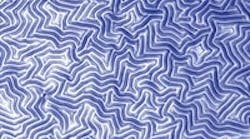The National Institute of Standards and Technology (NIST), Gaithersburg, Md., has developed a method for testing the strength of thin films. The method, called SIEBIMM for strain-induced elastic buckling instability for mechanical measurements, builds on the science of buckling, which studies crumbling buildings and crumpling of the Earth’s crust.The test can determine whether thin films — some no thicker than a single molecule — are strong enough for a growing number of technology applications. The method is quick and easy to run.Thin Film under Stress
This optical micrograph shows the isotropic buckling of a silicone-supported nanoporous film subjected to the SIEBIMM method. This type of film is a low-dielectric-constant film used for next-generation integrated circuits.
The method entails mounting a postage-stamp-sized assortment of incrementally varying, thin films on a strip of silicone rubber about the size of a Band-Aid. The samples are then subjected to a gradually increasing force that stretches or squeezes. The films become unstable and buckle, wrinkling like a piece of corrugated cardboard. The samples are subjected to a laser while a camera captures the light scattered at this critical point of instability. The resulting diffraction pattern determines the buckling wavelength, or distance between the peaks of adjacent wrinkles. Through a series of mathematical calculations, the buckling wavelength can be related directly to the elastic modulus of the sample, which corresponds to the strength of the material.SIEBIMM can evaluate all types and combinations of materials. The new method measures and analyzes the strength and stiffness of a thin-film sample in about two seconds, compared to indentation and other conventional approaches that take several minutes. In addition, the NIST-developed technique accommodates high-throughput testing, so that up to a few thousand systematically varying samples can be tested in rapid succession.For measuring mechanical properties of thin films (less than 1 m), existing tools often provide only relative values. This can make it difficult to predict how different films will perform. In contrast, the new method yields quantitative measurements that permit definitive comparisons between samples.“This simple technique can provide invaluable information concerning the mechanics of nanostructured materials and ultrathin polymer films,” says Christopher Stafford, a NIST polymer scientist.The SIEBIMM method was developed at the NIST Combinatorial Methods Center (www.nist.gov/combi), which develops rapid, high-throughput technologies to accelerate the discovery and application of new materials.
The method entails mounting a postage-stamp-sized assortment of incrementally varying, thin films on a strip of silicone rubber about the size of a Band-Aid. The samples are then subjected to a gradually increasing force that stretches or squeezes. The films become unstable and buckle, wrinkling like a piece of corrugated cardboard. The samples are subjected to a laser while a camera captures the light scattered at this critical point of instability. The resulting diffraction pattern determines the buckling wavelength, or distance between the peaks of adjacent wrinkles. Through a series of mathematical calculations, the buckling wavelength can be related directly to the elastic modulus of the sample, which corresponds to the strength of the material.SIEBIMM can evaluate all types and combinations of materials. The new method measures and analyzes the strength and stiffness of a thin-film sample in about two seconds, compared to indentation and other conventional approaches that take several minutes. In addition, the NIST-developed technique accommodates high-throughput testing, so that up to a few thousand systematically varying samples can be tested in rapid succession.For measuring mechanical properties of thin films (less than 1 m), existing tools often provide only relative values. This can make it difficult to predict how different films will perform. In contrast, the new method yields quantitative measurements that permit definitive comparisons between samples.“This simple technique can provide invaluable information concerning the mechanics of nanostructured materials and ultrathin polymer films,” says Christopher Stafford, a NIST polymer scientist.The SIEBIMM method was developed at the NIST Combinatorial Methods Center (www.nist.gov/combi), which develops rapid, high-throughput technologies to accelerate the discovery and application of new materials.


